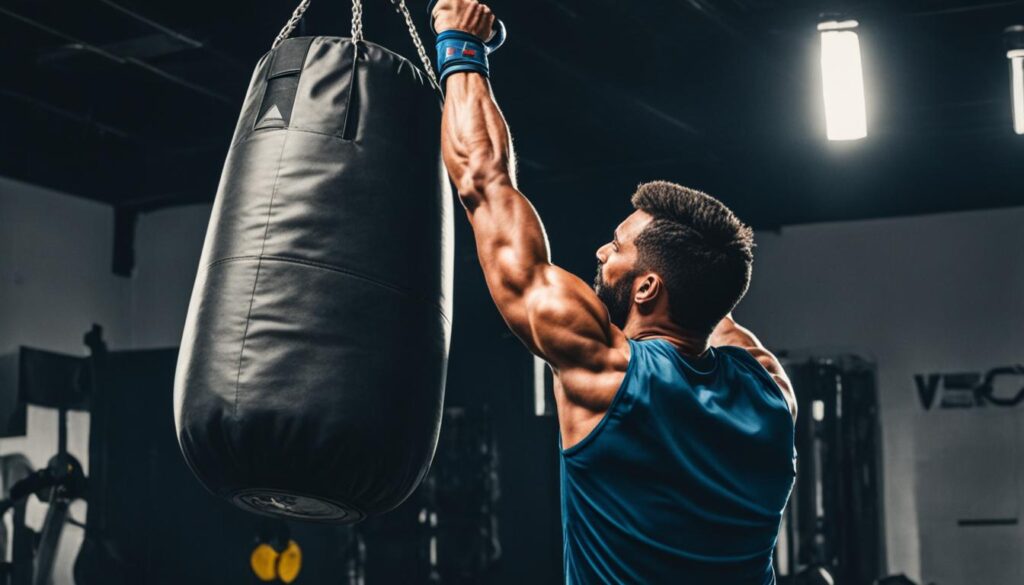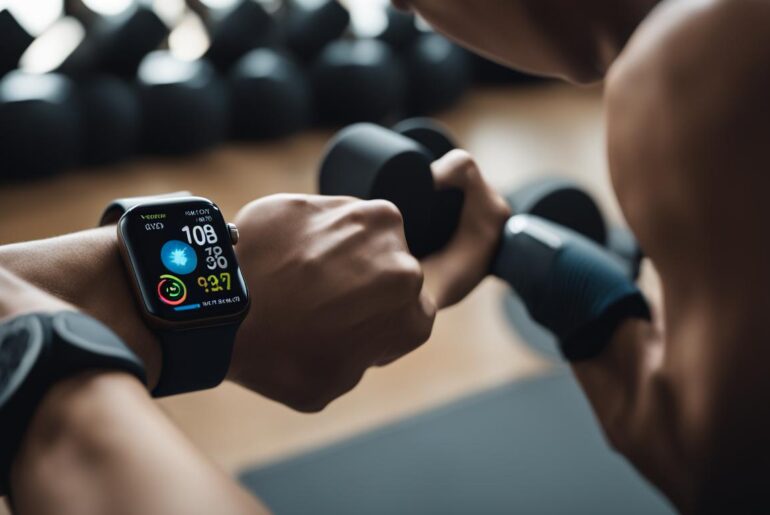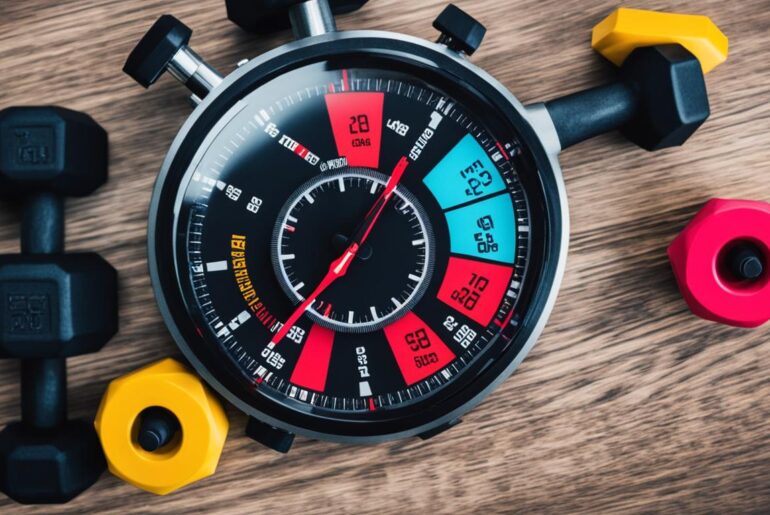In the world of combat sports, athletes face the challenge of balancing raw strength with enduring endurance. To excel in combat sports, athletes must possess not only explosive power but also the ability to sustain their performance over extended periods.
This delicate dance between strength and endurance is where combat strength training comes in. It is a specialized training method designed to enhance the physical prowess of combat athletes, equipping them with the tools necessary to dominate their opponents.
Combat strength training encompasses a range of exercises and techniques that target specific muscle groups and replicate movements relevant to combat sports. By incorporating these training methods into their routines, athletes can develop the explosive power, speed, agility, and overall conditioning required to excel in the world of combat sports.
Key Takeaways:
- Combat strength training is essential for combat athletes to maximize their performance.
- It focuses on developing explosive power, speed, agility, and overall conditioning.
- Combining strength and endurance training is crucial for combat sports success.
- Proper nutrition plays a vital role in fueling the body for optimal performance.
- Mental fortitude is crucial in maintaining focus and endurance during combat sports.
The Battle Within: Strength vs. Endurance
Combat athletes face an ongoing battle between strength and endurance. As they train, they constantly strive to find the delicate balance between delivering powerful strikes and maintaining peak performance over extended periods.
Strength is the foundation that allows combat athletes to unleash bone-crushing blows, overpowering their opponents and dominating in the arena. It is the raw power that can turn the tide of a fight in an instant.
Endurance, on the other hand, enables combat athletes to endure relentless assaults from their opponents. It gives them the ability to keep going even when their bodies are pushed to the limit, allowing them to withstand the grueling demands of combat sports.
The Interplay Between Strength and Endurance
As combat athletes work to strike a balance between strength and endurance, they must carefully consider their training approach. Maximal strength training helps build the foundation for powerful strikes, while endurance training ensures they can sustain their performance throughout the duration of a fight.
“Finding that sweet spot between strength and endurance is crucial for combat athletes. It’s about being able to deliver devastating blows while also having the stamina and resilience to keep going, no matter what.” – World Champion Fighter
Effective combat training involves a combination of strength-building exercises, such as weightlifting and resistance training, and endurance-focused workouts like cardio exercises and interval training. By incorporating both into their training regimen, combat athletes can develop the necessary power and stamina to excel in the ring.
Building Power and Stamina: A Balanced Approach
A balanced approach to combat training is essential for combat athletes to maximize their potential in the arena. Training for strength and endurance should go hand in hand, with each component complementing the other.
Strength training exercises, such as squats, deadlifts, and bench presses, help build muscle mass and increase power. These exercises should be performed with proper form and gradually increased in intensity over time.
On the other hand, endurance training focuses on improving cardiovascular fitness and stamina. High-intensity interval training (HIIT), running, and sport-specific drills are great ways to enhance endurance levels and simulate the demands of a fight.
By incorporating both strength and endurance training into their routines, combat athletes can achieve a harmonious balance that will enable them to showcase their full potential in the ring.
| Strength | Endurance |
|---|---|
| Allows for powerful strikes | Enables athletes to withstand relentless assaults |
| Builds muscle mass | Improves cardiovascular fitness |
| Fuels explosive movements | Increases stamina |
| Requires resistance training | Incorporates cardio exercises |
The Pendulum Effect: Swinging Between Strength and Endurance

Combat training is a dynamic process that requires athletes to swing between phases of strength emphasis and endurance emphasis. This ebb and flow is crucial in developing well-rounded combat skills and achieving peak performance in the ring or octagon.
In the early stages of combat training, athletes place a strong emphasis on building strength. This is achieved through various resistance training techniques, including powerlifting exercises that target specific muscle groups. By focusing on developing power and explosive strength, combat athletes lay the foundation for their physical prowess.
As a fight approaches, the training emphasis gradually shifts towards endurance. Athletes engage in high-intensity interval training (HIIT) and sport-specific drills that simulate the demands of combat. These activities help combat athletes improve their cardiovascular capacity, muscular endurance, and the ability to maintain a high level of performance over prolonged periods.
The use of periodization, a structured approach to training, is a key component in balancing the emphasis on strength and endurance throughout the training cycle. Periodization allows fighters to strategically plan their training phases, ensuring they reach their peak performance at the right time. By alternating between strength and endurance emphasis, athletes can optimize their training adaptations and achieve optimal results.
“The strategic use of periodization in combat training helps fighters strike the perfect balance between strength and endurance, allowing them to excel in the demanding arena of combat sports.”
By embracing the pendulum effect and incorporating both strength and endurance training phases into their routines, combat athletes can develop a well-rounded skill set and maximize their performance potential. Balancing these two elements is crucial in combat sports, where success often hinges on the ability to deliver powerful strikes while maintaining the physical and mental stamina to endure the demands of intense bouts.
Listening to the Body and Nutrition as the Silent Champion
While periodization provides a structured approach to combat training, it’s essential to listen to the body and tailor training to individual needs. Each athlete is unique, with varying strengths, weaknesses, and recovery capabilities. Personalized training allows combat athletes to optimize their performance by focusing on specific areas that require improvement.
Understanding your body’s signals is crucial in determining the appropriate training intensity, volume, and frequency. Overtraining can lead to fatigue, injuries, and hinder progress. By attentively monitoring your body’s responses, you can make necessary adjustments to ensure continual growth and prevent burnout.
“Tuning in and listening to your body is key to long-term success in combat sports. It enables you to strike a balance between pushing your limits and avoiding overexertion.”
Nutrition for Optimal Combat Training
In addition to personalized training, proper nutrition plays a vital role in fueling the body for combat training. Combat athletes require a well-balanced diet that supports their intense physical demands. Adequate intake of macronutrients is essential to enhance performance, aid recovery, and promote overall well-being.
Carbohydrates are the primary source of energy, supplying fuel for intense training sessions and bouts. Opt for complex carbohydrates like whole grains, fruits, and vegetables, as they provide sustained energy levels throughout the day.
Proteins are essential for muscle repair and growth. Include lean sources of protein such as poultry, fish, eggs, and plant-based alternatives like beans and tofu. Aim to distribute protein intake evenly throughout the day to optimize muscle synthesis.
Healthy fats are crucial for combat athletes as they provide sustained energy, support hormone production, and aid in the absorption of fat-soluble vitamins. Incorporate sources of monounsaturated and polyunsaturated fats, such as avocados, nuts, seeds, and fatty fish like salmon.
Implementing proper nutrition and personalized training strategies empowers combat athletes to optimize their performance, reduce the risk of injuries, and achieve peak physical condition.
Mental Fortitude: The Unseen Force

In the realm of combat sports, mental fortitude plays an integral role in an athlete’s performance. The ability to overcome exhaustion and stay focused amidst the chaos of a fight can be the deciding factor between victory and defeat. It is the unseen force that empowers fighters to dig deep within themselves and push beyond their limits.
Combat sports psychology recognizes the importance of mental training in developing this essential attribute. Athletes cultivate mental fortitude through various techniques that strengthen their mindset and prepare them for the challenges they will face. Visualization is one such technique, where fighters create vivid mental images of success, improving confidence and sharpening their focus.
Mindfulness, another powerful mental training technique, teaches combat athletes to remain fully present in the moment. By cultivating awareness of their thoughts, emotions, and physical sensations, fighters can sidestep distractions and maintain clarity of mind. This heightened state of awareness enables them to react swiftly and make split-second decisions, giving them a competitive edge.
Positive self-talk is a crucial component of mental fortitude. Combat athletes strive to replace negative thoughts with empowering affirmations that fuel their confidence and resilience. By reinforcing positive beliefs and banishing self-doubt, fighters build an unwavering mental foundation that helps them stay strong and focused in the face of adversity.
The Power of Mental Fortitude
The mind is a battlefield where victories are won long before the first punch is thrown. Mental fortitude is the secret weapon that separates champions from contenders. It allows fighters to navigate the physical demands of combat sports with unwavering focus and unshakeable resilience.
Mental fortitude is not only essential during fights but also throughout the rigorous training that precedes them. It enables athletes to endure grueling workouts, persist in the face of setbacks, and maintain motivation during the most challenging times.
The Impact of Mental Strength on Performance
Research in combat sports psychology has consistently shown that athletes with well-developed mental fortitude perform better under pressure. They exhibit heightened concentration, react quicker to their opponents’ moves, and make strategic decisions with clarity and precision.
Mental training not only enhances performance but also helps combat athletes manage stress and anxiety. By equipping fighters with effective coping mechanisms, it allows them to stay calm and composed in high-pressure situations, making it easier to execute their game plans and adapt to changing circumstances.
Unlocking Your Mental Fortitude
- Visualize success: Spend time envisioning yourself achieving your goals, visualizing every detail of your triumph.
- Practice mindfulness: Cultivate present-moment awareness, focusing on your breath, sensations, and thoughts without judgment.
- Engage in positive self-talk: Replace self-deprecating thoughts with empowering affirmations to boost your confidence and motivation.
- Seek professional guidance: Work with a sports psychologist or mental performance coach to develop a personalized mental training plan.
| Benefits of Mental Fortitude in Combat Sports | How Mental Strength Impacts Performance |
|---|---|
| Improved focus and concentration | Heightened reaction time and decision-making |
| Enhanced resilience and perseverance | Effective stress and anxiety management |
| Increased confidence and self-belief | Ability to adapt and adjust strategies |
| Greater composure under pressure | Maintaining optimal performance in high-stakes situations |
Developing mental fortitude is an ongoing process that requires dedication, discipline, and perseverance. By incorporating mental training into their routines, combat athletes can unlock their full potential and elevate their performance in the demanding world of combat sports.
Conclusion
Achieving greatness in combat sports hinges on the delicate balance of strength and endurance. Combat strength training equips athletes with the necessary tools and methodologies to cultivate power, stamina, and tactical effectiveness. By incorporating strength training into their routines and prioritizing personalized training and nutrition, combat athletes can unlock their full potential and reach peak performance in the unforgiving arena of combat sports.
Combat sports training goes beyond physical conditioning; it demands mental fortitude and strategic preparation. Athletes must delve into the depths of their mental resilience, harnessing visualization, mindfulness, and positive self-talk as invaluable assets. The fusion of physical and mental training creates a formidable force capable of conquering any opponent.
As combat sports continue to evolve, athletes must embrace a comprehensive approach to their development. By seamlessly blending combat strength training, personalized training cycles, optimal nutrition, and mental resilience, fighters can ascend to new heights of excellence. The path to greatness is paved with commitment, determination, and a relentless pursuit of strength, endurance, and tactical mastery.




